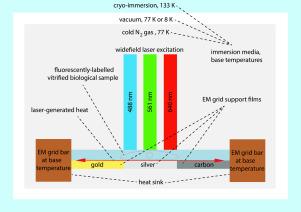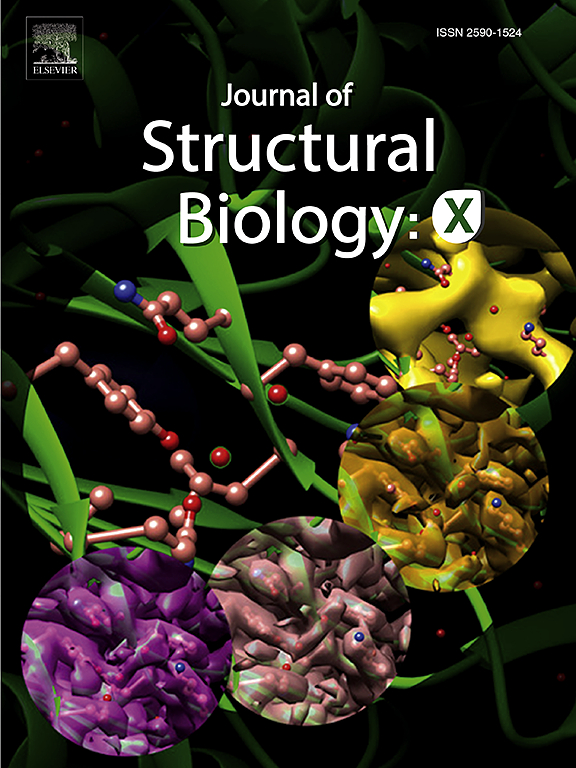基底温度、浸泡介质和EM栅格材料对低温光学超分辨显微镜反玻化阈值的影响
IF 2.7
3区 生物学
Q3 BIOCHEMISTRY & MOLECULAR BIOLOGY
引用次数: 0
摘要
低温相关光电子显微镜(cryo-CLEM)是一种集成了特定分子标记和分子分辨率结构信息的成像策略。然而,在衍射极限荧光显微镜和电子显微镜(EM)之间存在两个数量级以上的分辨率差距。在低温下进行的单分子定位显微镜(SMLM)有望弥合这一分辨率差距。然而,SMLM所需的高激发激光功率有可能导致冷冻生物样品的反玻璃化,导致其原生态的扰动。在这里,我们研究了基底冷却温度、浸泡介质和EM网格支撑材料如何影响样品的脱玻化。通过有限元模拟和实验验证,我们发现低温浸泡介质增强了碳支架的散热,而低温氮气介质中的金属支架由于基底温度较低,可以承受更高的激光强度。在640nm照射下,金支架显示出明显的高激光阈值,类似于镀银网格。此外,金属支撑在真空低温恒温器中保持有效的散热。我们的研究结果提供了定量的见解,有助于优化冷冻- smlm设置,以改善冷冻- clem成像。本文章由计算机程序翻译,如有差异,请以英文原文为准。

Effects of base temperature, immersion medium, and EM grid material on devitrification thresholds in cryogenic optical super-resolution microscopy
Cryogenic correlative light and electron microscopy (cryo-CLEM) is an imaging strategy that integrates specific molecular labeling and molecular resolution structural information. However, there is a resolution gap of more than two orders of magnitude between diffraction-limited fluorescence microscopy and electron microscopy (EM). Single-molecule localization microscopy (SMLM) performed at cryogenic temperatures promises to bridge this resolution gap. Nevertheless, the high excitation laser powers required for SMLM risk the devitrification of frozen biological samples, leading to perturbation of their native-like state. Here, we investigate how base cooling temperature, immersion medium, and EM grid support materials influence sample devitrification. Using finite element simulations and experimental validation, we show that a cryo-immersion medium enhances heat dissipation for carbon supports, while metallic supports in a cold nitrogen gas medium tolerate higher laser intensities due to lower base temperatures. Gold supports illuminated at exhibit markedly high laser thresholds, similar to silver-coated grids. Additionally, metallic supports maintain efficient heat dissipation in vacuum-based cryostats. Our findings provide quantitative insights that aid in optimization of cryo-SMLM setups for improved cryo-CLEM imaging.
求助全文
通过发布文献求助,成功后即可免费获取论文全文。
去求助
来源期刊

Journal of structural biology
生物-生化与分子生物学
CiteScore
6.30
自引率
3.30%
发文量
88
审稿时长
65 days
期刊介绍:
Journal of Structural Biology (JSB) has an open access mirror journal, the Journal of Structural Biology: X (JSBX), sharing the same aims and scope, editorial team, submission system and rigorous peer review. Since both journals share the same editorial system, you may submit your manuscript via either journal homepage. You will be prompted during submission (and revision) to choose in which to publish your article. The editors and reviewers are not aware of the choice you made until the article has been published online. JSB and JSBX publish papers dealing with the structural analysis of living material at every level of organization by all methods that lead to an understanding of biological function in terms of molecular and supermolecular structure.
Techniques covered include:
• Light microscopy including confocal microscopy
• All types of electron microscopy
• X-ray diffraction
• Nuclear magnetic resonance
• Scanning force microscopy, scanning probe microscopy, and tunneling microscopy
• Digital image processing
• Computational insights into structure
 求助内容:
求助内容: 应助结果提醒方式:
应助结果提醒方式:


